Extracellular Matrix Changes in Subcellular Brain Fractions and Cerebrospinal Fluid of Alzheimer’s Disease Patients
Abstract
1. Introduction
2. Results
2.1. Regulation of Key Components of Neural ECM in AD Brains (Post-Mortem Analysis)
2.2. Gene Expression Analysis of ECM Components in AD Brains (RNAseq Analysis)
2.3. Brevican and Neurocan Levels in the CSF of AD Subjects
3. Discussion
3.1. Brevican and Neurocan in AD Brains
3.2. HAPLN1 and Aggrecan in AD Brains
3.3. Brevican and Neurocan in the CSF: Markers for Dementia, Neurodegeneration, or Just Age?
3.4. Limitations of the Study
4. Materials and Methods
4.1. Post-Mortem Brain Samples from Graz
4.2. Neurological Assessment of the Patient Cohort from Magdeburg
4.3. CSF Sample Collection and Biomarker Measurements
4.4. Ethics and Informed Consent
4.5. Antibodies
4.6. Enzyme-Linked Immunosorbent Assay (ELISA) Protocols
4.7. Brain Fractionation and Immunoblotting
4.8. Analysis of RNAseq Data
4.9. Statistical Analysis of Data
Supplementary Materials
Author Contributions
Funding
Institutional Review Board Statement
Informed Consent Statement
Data Availability Statement
Acknowledgments
Conflicts of Interest
References
- Braak, H.; Braak, E. Neuropathological stageing of Alzheimer-related changes. Acta Neuropathol. 1991, 82, 239–259. [Google Scholar] [CrossRef]
- Mirra, S.S.; Heyman, A.; McKeel, D.; Sumi, S.M.; Crain, B.J.; Brownlee, L.M.; Vogel, F.S.; Hughes, J.P.; van Belle, G.; Berg, L. The Consortium to Establish a Registry for Alzheimer’s Disease (CERAD). Part II. Standardization of the neuropathologic assessment of Alzheimer’s disease. Neurology 1991, 41, 479–486. [Google Scholar] [CrossRef] [PubMed]
- Jack, C.R.; Bennett, D.A.; Blennow, K.; Carrillo, M.C.; Feldman, H.H.; Frisoni, G.B.; Hampel, H.; Jagust, W.J.; Johnson, K.A.; Knopman, D.S.; et al. A/T/N: An unbiased descriptive classification scheme for Alzheimer disease biomarkers. Neurology 2016, 87, 539–547. [Google Scholar] [CrossRef] [PubMed]
- Bacioglu, M.; Maia, L.F.; Preische, O.; Schelle, J.; Apel, A.; Kaeser, S.A.; Schweighauser, M.; Eninger, T.; Lambert, M.; Pilotto, A.; et al. Neurofilament Light Chain in Blood and CSF as Marker of Disease Progression in Mouse Models and in Neurodegenerative Diseases. Neuron 2016, 91, 56–66. [Google Scholar] [CrossRef] [PubMed]
- Planche, V.; Manjon, J.V.; Mansencal, B.; Lanuza, E.; Tourdias, T.; Catheline, G.; Coupé, P. Structural progression of Alzheimer’s disease over decades: The MRI staging scheme. Brain Commun. 2022, 4, fcac109. [Google Scholar] [CrossRef]
- Huffels, C.F.M.; Middeldorp, J.; Hol, E.M. Aß Pathology and Neuron-Glia Interactions: A Synaptocentric View. Neurochem. Res. 2022. [Google Scholar] [CrossRef]
- Celesia, G.G. Alzheimer’s disease: The proteoglycans hypothesis. Semin. Thromb. Hemost. 1991, 17 (Suppl. S2), 158–160. [Google Scholar]
- Frischknecht, R.; Chang, K.-J.; Rasband, M.N.; Seidenbecher, C.I. Neural ECM molecules in axonal and synaptic homeostatic plasticity. Prog. Brain Res. 2014, 214, 81–100. [Google Scholar] [CrossRef]
- Morawski, M.; Brückner, M.K.; Riederer, P.; Brückner, G.; Arendt, T. Perineuronal nets potentially protect against oxidative stress. Exp. Neurol. 2004, 188, 309–315. [Google Scholar] [CrossRef]
- Morawski, M.; Brückner, G.; Jäger, C.; Seeger, G.; Arendt, T. Neurons associated with aggrecan-based perineuronal nets are protected against tau pathology in subcortical regions in Alzheimer’s disease. Neuroscience 2010, 169, 1347–1363. [Google Scholar] [CrossRef]
- Suttkus, A.; Holzer, M.; Morawski, M.; Arendt, T. The neuronal extracellular matrix restricts distribution and internalization of aggregated Tau-protein. Neuroscience 2016, 313, 225–235. [Google Scholar] [CrossRef]
- Maeda, S.; Yamada, J.; Iinuma, K.M.; Nadanaka, S.; Kitagawa, H.; Jinno, S. Chondroitin sulfate proteoglycan is a potential target of memantine to improve cognitive function via the promotion of adult neurogenesis. Br. J. Pharmacol. 2022, 179, 4857–4877. [Google Scholar] [CrossRef] [PubMed]
- Zhao, J.; Yu, Y.; Wu, Z.; Wang, L.; Li, W. Memantine inhibits degradation of the articular cartilage extracellular matrix induced by advanced glycation end products (AGEs). Biomed. Pharmacother. 2017, 91, 1193–1198. [Google Scholar] [CrossRef] [PubMed]
- Scarlett, J.M.; Hu, S.J.; Alonge, K.M. The “Loss” of Perineuronal Nets in Alzheimer’s Disease: Missing or Hiding in Plain Sight? Front. Integr. Neurosci. 2022, 16, 896400. [Google Scholar] [CrossRef] [PubMed]
- Koopmans, F.; van Nierop, P.; Andres-Alonso, M.; Byrnes, A.; Cijsouw, T.; Coba, M.P.; Cornelisse, L.N.; Farrell, R.J.; Goldschmidt, H.L.; Howrigan, D.P.; et al. SynGO: An Evidence-Based, Expert-Curated Knowledge Base for the Synapse. Neuron 2019, 103, 217–234.e4. [Google Scholar] [CrossRef]
- Viapiano, M.S.; Bi, W.L.; Piepmeier, J.; Hockfield, S.; Matthews, R.T. Novel tumor-specific isoforms of BEHAB/brevican identified in human malignant gliomas. Cancer Res. 2005, 65, 6726–6733. [Google Scholar] [CrossRef] [PubMed]
- Crapser, J.D.; Spangenberg, E.E.; Barahona, R.A.; Arreola, M.A.; Hohsfield, L.A.; Green, K.N. Microglia facilitate loss of perineuronal nets in the Alzheimer’s disease brain. EBioMedicine 2020, 58, 102919. [Google Scholar] [CrossRef]
- Minta, K.; Portelius, E.; Janelidze, S.; Hansson, O.; Zetterberg, H.; Blennow, K.; Andreasson, U. Cerebrospinal Fluid Concentrations of Extracellular Matrix Proteins in Alzheimer’s Disease. J. Alzheimer’s Dis. 2019, 69, 1213–1220. [Google Scholar] [CrossRef]
- Minta, K.; Brinkmalm, G.; Portelius, E.; Johansson, P.; Svensson, J.; Kettunen, P.; Wallin, A.; Zetterberg, H.; Blennow, K.; Andreasson, U. Brevican and Neurocan Peptides as Potential Cerebrospinal Fluid Biomarkers for Differentiation Between Vascular Dementia and Alzheimer’s Disease. J. Alzheimer’s Dis. 2021, 79, 729–741. [Google Scholar] [CrossRef]
- Suárez-Calvet, M.; Capell, A.; Araque Caballero, M.Á.; Morenas-Rodríguez, E.; Fellerer, K.; Franzmeier, N.; Kleinberger, G.; Eren, E.; Deming, Y.; Piccio, L.; et al. CSF progranulin increases in the course of Alzheimer’s disease and is associated with sTREM2, neurodegeneration and cognitive decline. EMBO Mol. Med. 2018, 10, e9712. [Google Scholar] [CrossRef]
- Morawski, M.; Brückner, G.; Jäger, C.; Seeger, G.; Matthews, R.T.; Arendt, T. Involvement of perineuronal and perisynaptic extracellular matrix in Alzheimer’s disease neuropathology. Brain Pathol. 2012, 22, 547–561. [Google Scholar] [CrossRef]
- Lendvai, D.; Morawski, M.; Négyessy, L.; Gáti, G.; Jäger, C.; Baksa, G.; Glasz, T.; Attems, J.; Tanila, H.; Arendt, T.; et al. Neurochemical mapping of the human hippocampus reveals perisynaptic matrix around functional synapses in Alzheimer’s disease. Acta Neuropathol. 2013, 125, 215–229. [Google Scholar] [CrossRef]
- Yan, Z.; Rein, B. Mechanisms of synaptic transmission dysregulation in the prefrontal cortex: Pathophysiological implications. Mol. Psychiatry 2022, 27, 445–465. [Google Scholar] [CrossRef] [PubMed]
- Favuzzi, E.; Marques-Smith, A.; Deogracias, R.; Winterflood, C.M.; Sánchez-Aguilera, A.; Mantoan, L.; Maeso, P.; Fernandes, C.; Ewers, H.; Rico, B. Activity-Dependent Gating of Parvalbumin Interneuron Function by the Perineuronal Net Protein Brevican. Neuron 2017, 95, 639–655.e10. [Google Scholar] [CrossRef] [PubMed]
- Végh, M.J.; Heldring, C.M.; Kamphuis, W.; Hijazi, S.; Timmerman, A.J.; Li, K.W.; van Nierop, P.; Mansvelder, H.D.; Hol, E.M.; Smit, A.B.; et al. Reducing hippocampal extracellular matrix reverses early memory deficits in a mouse model of Alzheimer’s disease. Acta Neuropathol. Commun. 2014, 2, 76. [Google Scholar] [CrossRef] [PubMed]
- Metaxas, A.; Thygesen, C.; Kempf, S.J.; Anzalone, M.; Vaitheeswaran, R.; Petersen, S.; Landau, A.M.; Audrain, H.; Teeling, J.L.; Darvesh, S.; et al. Ageing and amyloidosis underlie the molecular and pathological alterations of tau in a mouse model of familial Alzheimer’s disease. Sci. Rep. 2019, 9, 15758. [Google Scholar] [CrossRef]
- Yan, H.; Zhu, X.; Xie, J.; Zhao, Y.; Liu, X. β-amyloid increases neurocan expression through regulating Sox9 in astrocytes: A potential relationship between Sox9 and chondroitin sulfate proteoglycans in Alzheimer’s disease. Brain Res. 2016, 1646, 377–383. [Google Scholar] [CrossRef]
- Matsumoto, K.; Shionyu, M.; Go, M.; Shimizu, K.; Shinomura, T.; Kimata, K.; Watanabe, H. Distinct interaction of versican/PG-M with hyaluronan and link protein. J. Biol. Chem. 2003, 278, 41205–41212. [Google Scholar] [CrossRef]
- Fawcett, J.W. Chapter 10—The extracellular matrix in plasticity and regeneration after CNS injury and neurodegenerative disease. Progr. Brain Res. 2015, 218, 213–226. [Google Scholar] [CrossRef]
- Aspberg, A.; Miura, R.; Bourdoulous, S.; Shimonaka, M.; Heinegârd, D.; Schachner, M.; Ruoslahti, E.; Yamaguchi, Y. The C-type lectin domains of lecticans, a family of aggregating chondroitin sulfate proteoglycans, bind tenascin-R by protein-protein interactions independent of carbohydrate moiety. Proc. Natl. Acad. Sci. USA 1997, 94, 10116–10121. [Google Scholar] [CrossRef]
- Guldbrandsen, A.; Vethe, H.; Farag, Y.; Oveland, E.; Garberg, H.; Berle, M.; Myhr, K.-M.; Opsahl, J.A.; Barsnes, H.; Berven, F.S. In-depth characterization of the cerebrospinal fluid (CSF) proteome displayed through the CSF proteome resource (CSF-PR). Mol. Cell. Proteom. 2014, 13, 3152–3163. [Google Scholar] [CrossRef] [PubMed]
- Hußler, W.; Höhn, L.; Stolz, C.; Vielhaber, S.; Garz, C.; Schmitt, F.C.; Gundelfinger, E.D.; Schreiber, S.; Seidenbecher, C.I. Brevican and Neurocan Cleavage Products in the Cerebrospinal Fluid—Differential Occurrence in ALS, Epilepsy and Small Vessel Disease. Front. Cell. Neurosci. 2022, 16, 838432. [Google Scholar] [CrossRef] [PubMed]
- Iliff, J.J.; Wang, M.; Liao, Y.; Plogg, B.A.; Peng, W.; Gundersen, G.A.; Benveniste, H.; Vates, E.; Deane, R.; Goldman, S.; et al. A paravascular pathway facilitates CSF flow through the brain parenchyma and the clearance of interstitial solutes, including amyloid b. Sci. Transl. Med. 2012, 4, 147ra111. [Google Scholar] [CrossRef] [PubMed]
- Brinkmalm, G.; Sjödin, S.; Simonsen, A.H.; Hasselbalch, S.G.; Zetterberg, H.; Brinkmalm, A.; Blennow, K. A Parallel Reaction Monitoring Mass Spectrometric Method for Analysis of Potential CSF Biomarkers for Alzheimer’s Disease. Proteomics Clin. Appl. 2018, 12. [Google Scholar] [CrossRef]
- Bader, J.M.; Geyer, P.E.; Müller, J.B.; Strauss, M.T.; Koch, M.; Leypoldt, F.; Koertvelyessy, P.; Bittner, D.; Schipke, C.G.; Incesoy, E.I.; et al. Proteome profiling in cerebrospinal fluid reveals novel biomarkers of Alzheimer’s disease. Mol. Syst. Biol. 2020, 16, e9356. [Google Scholar] [CrossRef]
- McKhann, G.; Drachman, D.; Folstein, M.; Katzman, R.; Price, D.; Stadlan, E.M. Clinical diagnosis of Alzheimer’s disease: Report of the NINCDS-ADRDA Work Group under the auspices of Department of Health and Human Services Task Force on Alzheimer’s Disease. Neurology 1984, 34, 939–944. [Google Scholar] [CrossRef]
- Folstein, M.F.; Folstein, S.E.; McHugh, P.R. “Mini-mental state”. A practical method for grading the cognitive state of patients for the clinician. J. Psychiatr. Res. 1975, 12, 189–198. [Google Scholar] [CrossRef]
- Schreiber, S.; Spotorno, N.; Schreiber, F.; Acosta-Cabronero, J.; Kaufmann, J.; Machts, J.; Debska-Vielhaber, G.; Garz, C.; Bittner, D.; Hensiek, N.; et al. Significance of CSF NfL and tau in ALS. J. Neurol. 2018, 265, 2633–2645. [Google Scholar] [CrossRef]
- Schreiber, S.; Debska-Vielhaber, G.; Abdulla, S.; Machts, J.; Schreiber, F.; Kropf, S.; KÖrtvelyessy, P.; KÖrner, S.; Kollewe, K.; Petri, S.; et al. Peripheral nerve atrophy together with higher cerebrospinal fluid progranulin indicate axonal damage in amyotrophic lateral sclerosis. Muscle Nerve 2018, 57, 273–278. [Google Scholar] [CrossRef]
- Mattsson, N.; Zetterberg, H.; Hansson, O.; Andreasen, N.; Parnetti, L.; Jonsson, M.; Herukka, S.K.; van der Flier, W.M.; Blankenstein, M.A.; Ewers, M.; et al. CSF biomarkers and incipient Alzheimer disease in patients with mild cognitive impairment. JAMA 2009, 302, 385–393. [Google Scholar] [CrossRef]
- Buchhave, P.; Minthon, L.; Zetterberg, H.; Wallin, A.K.; Blennow, K.; Hansson, O. Cerebrospinal fluid levels of β-amyloid 1-42, but not of tau, are fully changed already 5 to 10 years before the onset of Alzheimer dementia. Arch Gen Psychiatry. 2012, 69, 98–106. [Google Scholar] [CrossRef] [PubMed]
- Valenzuela, J.C.; Heise, C.; Franken, G.; Singh, J.; Schweitzer, B.; Seidenbecher, C.I.; Frischknecht, R. Hyaluronan-based extracellular matrix under conditions of homeostatic plasticity. Philos. Trans. R. Soc. Lond. B Biol. Sci. 2014, 369, 20130606. [Google Scholar] [CrossRef]
- Smalla, K.-H.; Klemmer, P.; Wyneken, U. Isolation of the Postsynaptic Density: A Specialization of the Subsynaptic Cytoskeleton. In The Cytoskeleton; Dermietzel, R., Ed.; Humana Press: Totowa, NJ, USA, 2013; pp. 265–280. ISBN 978-1-62703-265-0. [Google Scholar]
- Dinneen, L.C.; Blakesley, B.C. Algorithm AS 62: A Generator for the Sampling Distribution of the Mann- Whitney U Statistic. Appl. Stat. 1973, 22, 269. [Google Scholar] [CrossRef]
- Quade, D. Rank Analysis of Covariance. J. Am. Stat. Assoc. 1967, 62, 1187. [Google Scholar] [CrossRef]
- JASP, Version 0.17. Computer Software. JASP Team: Amsterdam, The Netherlands, 2023.
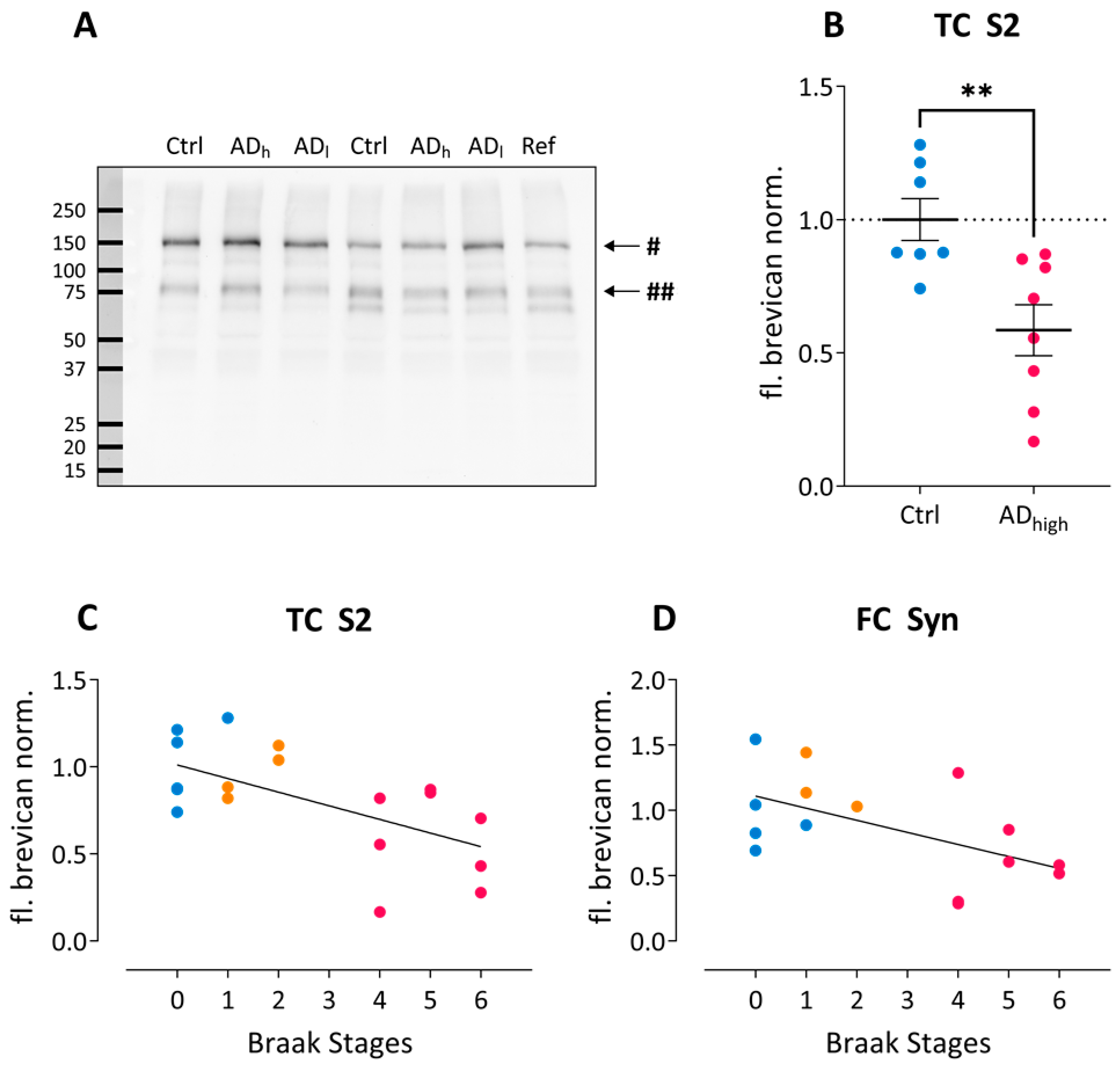
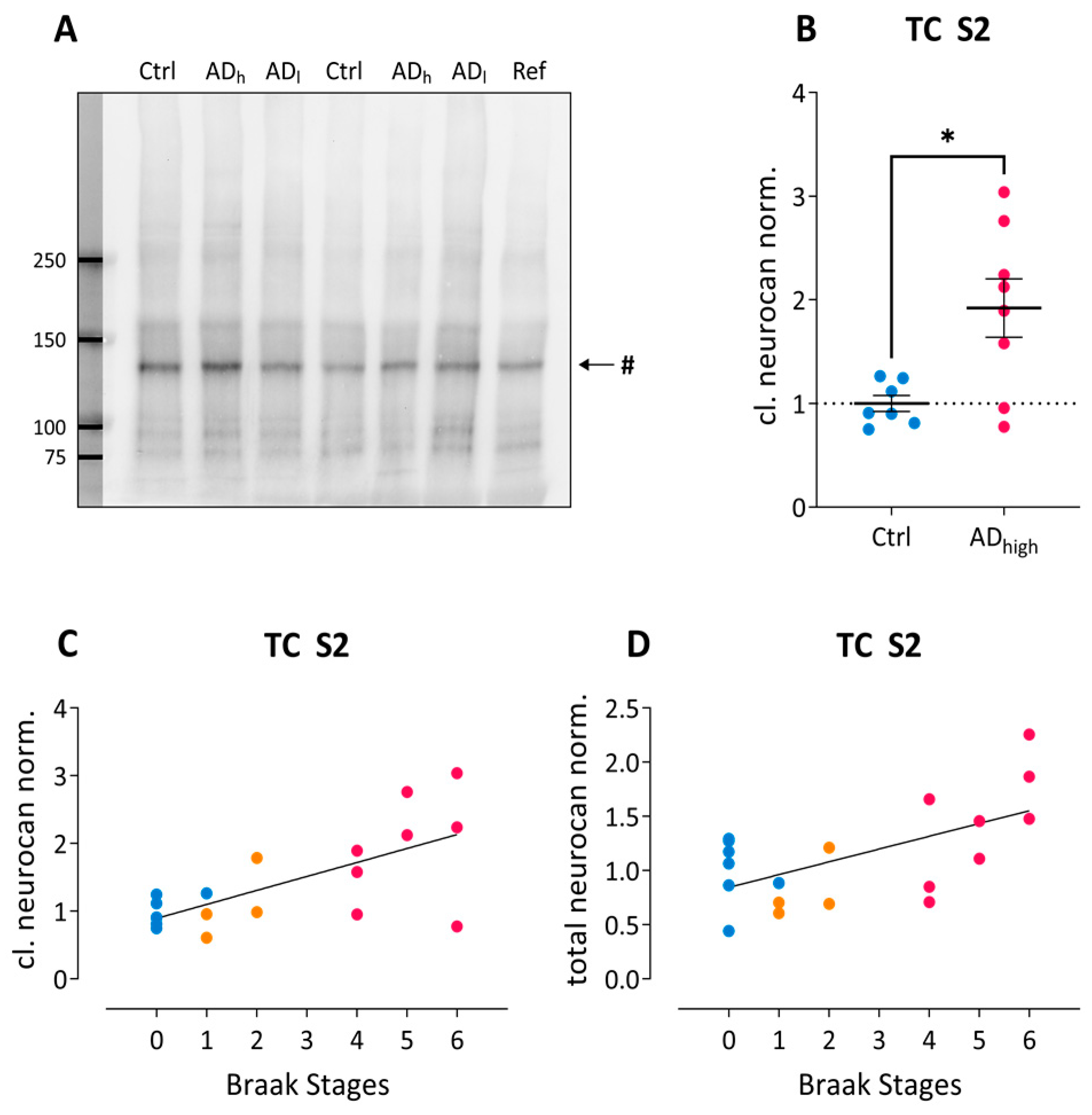
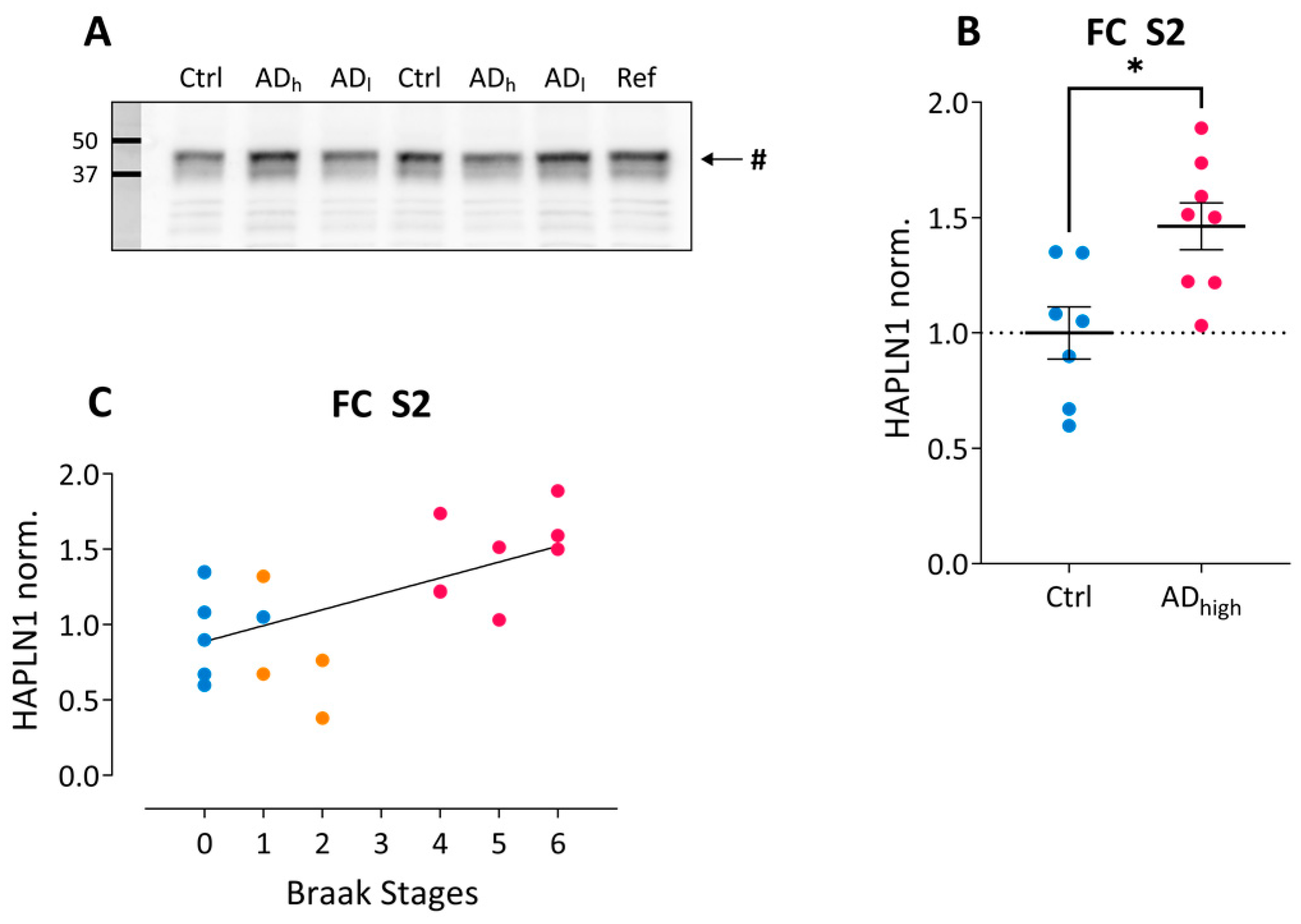
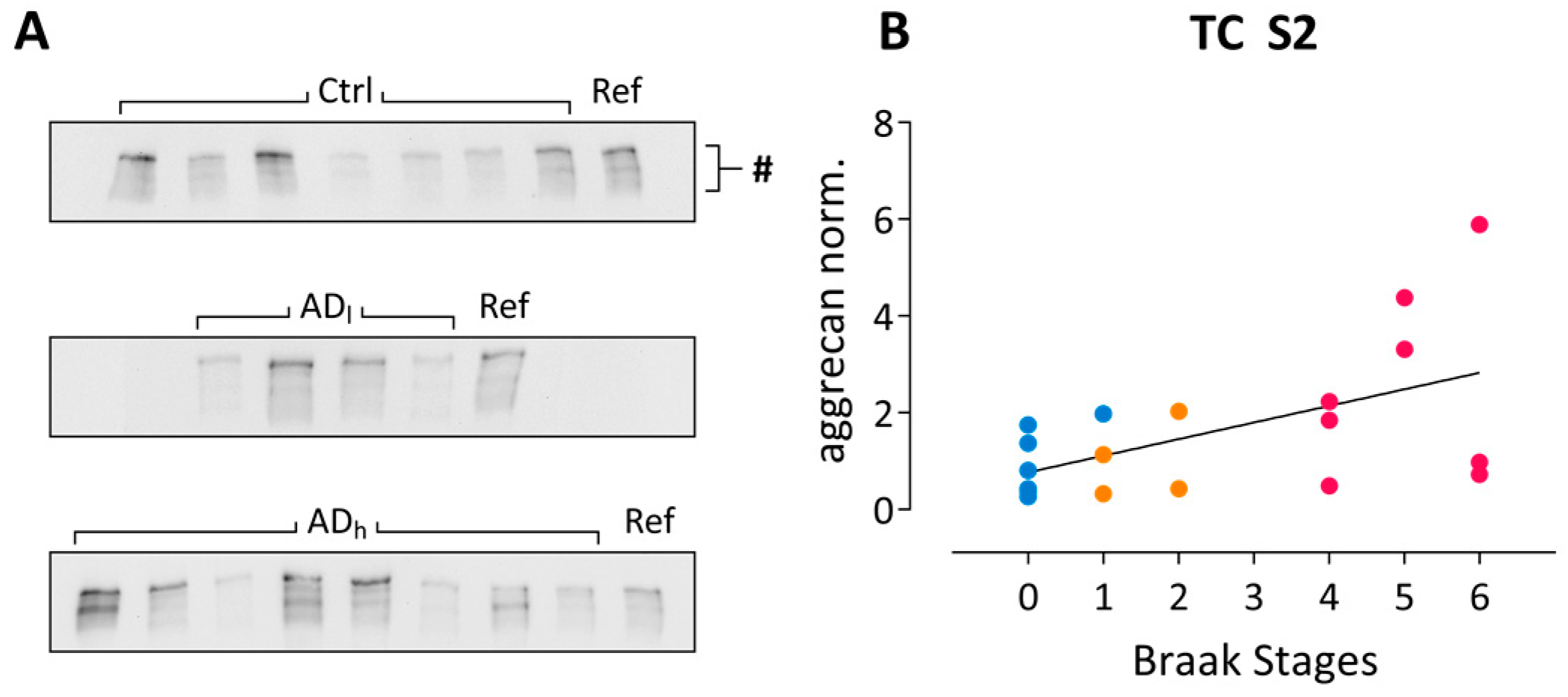
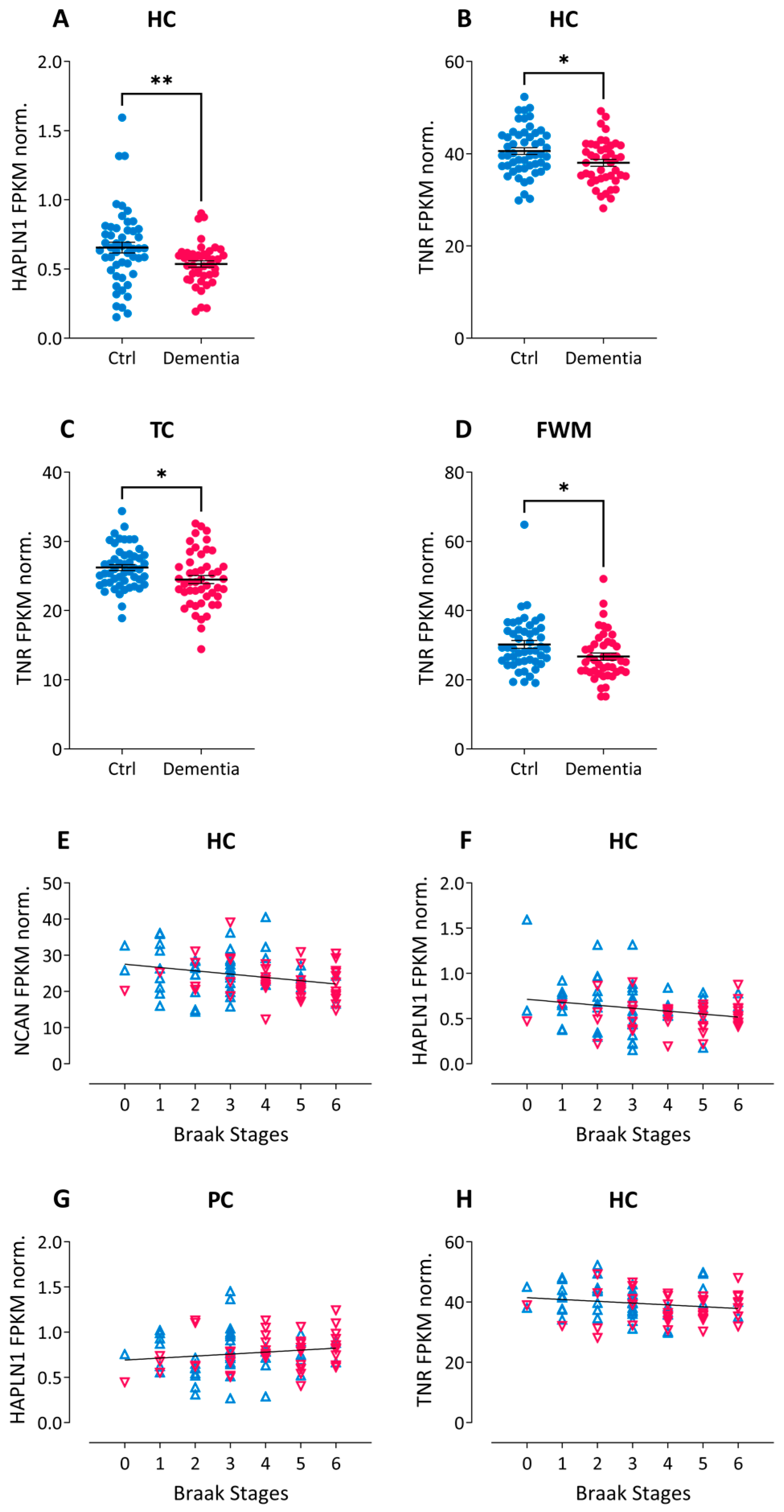

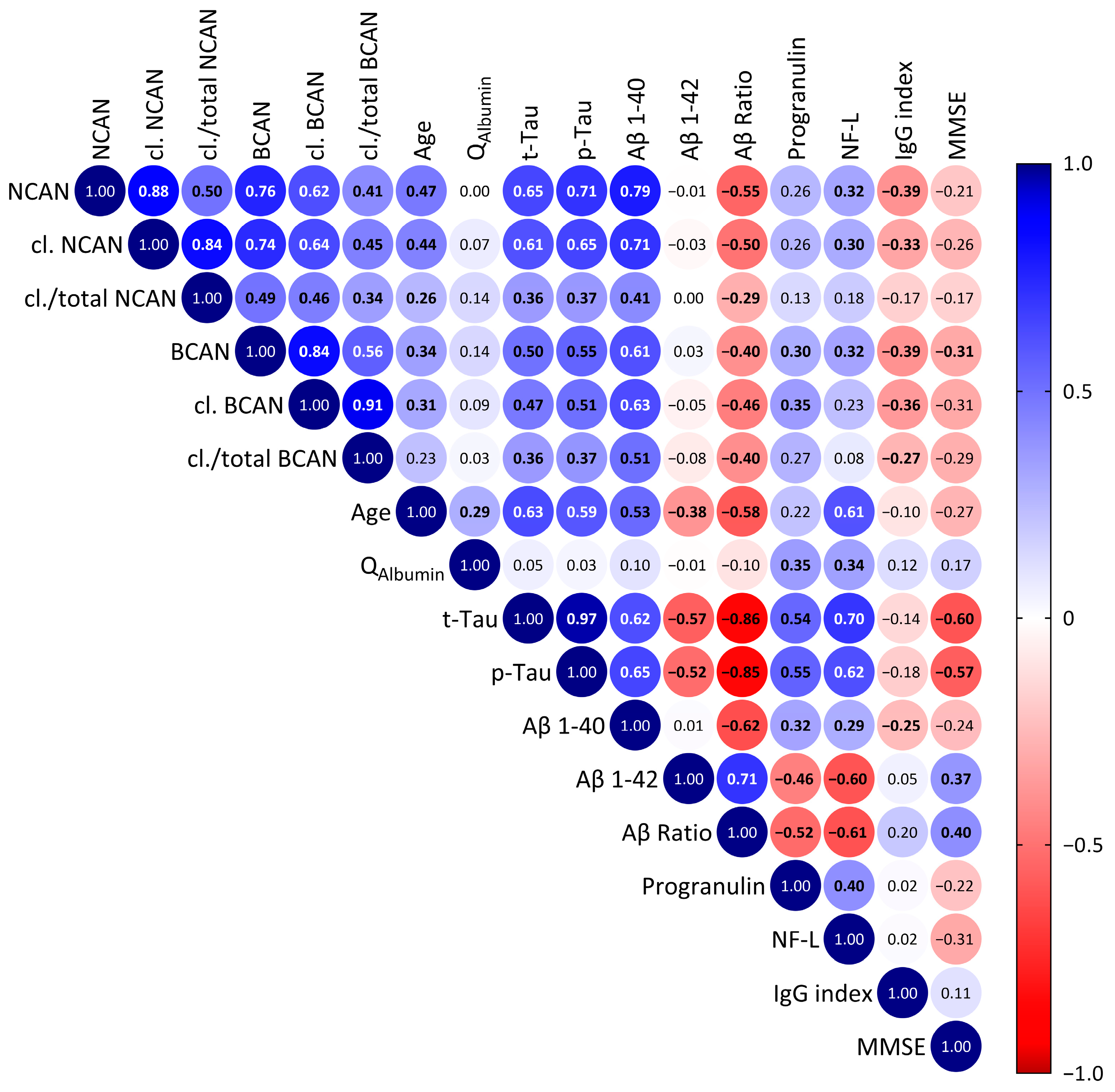

| n | Group/Subject | Braak Stage | CERAD Stage | Sex m/f | Mean Age (yrs; ±SD) | Mean PMI (h; ±SD) | Cause of Death by ICD-10 Chapter |
|---|---|---|---|---|---|---|---|
| 7 | Controls | 4/3 | 64.0 ± 7.0 | 15.4 ± 6.1 | |||
| 2 | 0 | 0 | m | 59 | 13.58 | Diseases of the respiratory system | |
| 3 | 0 | 0 | m | 60 | 7.00 | Diseases of the circulatory system | |
| 6 | 1 | 0 | m | 61 | 9.50 | Diseases of the circulatory system | |
| 8 | 0 | 0 | f | 78 | 20.60 | Diseases of the circulatory system | |
| 12 | 0 | 0 | m | 60 | 13.08 | Diseases of the respiratory system | |
| 13 | 0 | 0 | f | 61 | 21.97 | Symptoms, signs and abnormal clinical and laboratory findings, not elsewhere classified | |
| 14 | 0 | 0 | f | 69 | 21.75 | Neoplasm | |
| 4 | ADlow | 2/2 | 71.3 ± 14.1 | 12.7 ± 3.6 | |||
| 1 | 2 | A | m | 83 | 9.65 | Neoplasm | |
| 5 | 2 | A | f | 73 | 17.42 | Neoplasm | |
| 7 | 1 | A | m | 78 | 10.05 | Symptoms, signs and abnormal clinical and laboratory findings, not elsewhere classified | |
| 11 | 1 | A | f | 51 | 13.50 | Disease of the circulatory system | |
| 8 | ADhigh | 5/3 | 71.4 ± 11.0 | 20.0 ± 4.5 | |||
| 4 | 6 | C | f | 80 | 19.57 | Diseases of the circulatory system | |
| 9 | 4 | B | f | 70 | 18.42 | Diseases of the digestive system | |
| 10 | 4 | B | m | 59 | 10.27 | Diseases of the circulatory system | |
| 15 | 5 | C | m | 70 | 23.42 | Symptoms, signs and abnormal clinical and laboratory findings, not elsewhere classified | |
| 16 | 5 | C | m | 53 | 22.83 | Diseases of the circulatory system | |
| 17 | 6 | C | m | 81 | 24.33 | Diseases of the circulatory system | |
| 18 | 4 | B | m | 85 | 21.75 | Diseases of the circulatory system | |
| 19 | 6 | C | f | 73 | 19.50 | Diseases of the circulatory system | |
| 19 | Total cases | 11/8 | 68.6 ± 10.5 | 16.7 ± 5.6 | |||
| χ2 | 0.17 | 2.08 | 5.47 | ||||
| p | 0.917 | 0.354 | 0.065 | ||||
| Group | Age (yrs) | Sex (m/f) | Neurocan (ng/mL) | Brevican (ng/mL) | t-Tau (pg/mL) | p-Tau (pg/mL) | Aβ 1-40 (pg/mL) | Aβ 1-42 (pg/mL) | Aβ Ratio | Progr (ng/mL) | NF-L (pg/mL) | IgG Index | MMSE Score | |
|---|---|---|---|---|---|---|---|---|---|---|---|---|---|---|
| Controls | 63.4± 12.7 | 32.47 ± 10.28 | 249.8 ± 94.69 | 171.8 ± 66.2 | 38.30 ± 11.51 | 8054 ± 2371 | 978.2 ± 243.7 | 0.126 ± 0.026 | 0.73 ± 0.15 | 957 ± 546 | 0.52 ± 0.04 | 28.14 ± 0.69 | ||
| Mean ± SD | AD | 76.6 ± 6.4 | 43.31 ± 12.2 | 319.5 ± 120.1 | 799.5 ± 461.2 | 111.80 ± 45.09 | 11,284 ± 4185 | 534.2 ± 149.8 | 0.050 ± 0.015 | 0.99 ± 0.23 | 2017 ± 911 | 0.51 ± 0.05 | 19.52 ± 6.44 | |
| Total cases | 70.0 ± 12.0 | 37.89 ± 12.46 | 284.7 ± 112.9 | 490.2 ± 456.5 | 76.15 ± 49.65 | 9692 ± 3759 | 753 ± 300 | 0.088 ± 0.043 | 0.91 ± 0.24 | 1575 ± 936 | 0.51 ± 0.05 | 21.03 ± 6.72 | ||
| N of subjects | Controls | 17/18 | 35 | 35 | 34 | 33 | 34 | 34 | 34 | 16 | 25 | 35 | 7 | |
| AD | 7/28 | 35 | 35 | 35 | 35 | 35 | 35 | 35 | 35 | 35 | 35 | 33 | ||
| Total cases | 24/46 | 70 | 70 | 69 | 68 | 69 | 69 | 69 | 51 | 60 | 70 | 40 |
Disclaimer/Publisher’s Note: The statements, opinions and data contained in all publications are solely those of the individual author(s) and contributor(s) and not of MDPI and/or the editor(s). MDPI and/or the editor(s) disclaim responsibility for any injury to people or property resulting from any ideas, methods, instructions or products referred to in the content. |
© 2023 by the authors. Licensee MDPI, Basel, Switzerland. This article is an open access article distributed under the terms and conditions of the Creative Commons Attribution (CC BY) license (https://creativecommons.org/licenses/by/4.0/).
Share and Cite
Höhn, L.; Hußler, W.; Richter, A.; Smalla, K.-H.; Birkl-Toeglhofer, A.-M.; Birkl, C.; Vielhaber, S.; Leber, S.L.; Gundelfinger, E.D.; Haybaeck, J.; et al. Extracellular Matrix Changes in Subcellular Brain Fractions and Cerebrospinal Fluid of Alzheimer’s Disease Patients. Int. J. Mol. Sci. 2023, 24, 5532. https://doi.org/10.3390/ijms24065532
Höhn L, Hußler W, Richter A, Smalla K-H, Birkl-Toeglhofer A-M, Birkl C, Vielhaber S, Leber SL, Gundelfinger ED, Haybaeck J, et al. Extracellular Matrix Changes in Subcellular Brain Fractions and Cerebrospinal Fluid of Alzheimer’s Disease Patients. International Journal of Molecular Sciences. 2023; 24(6):5532. https://doi.org/10.3390/ijms24065532
Chicago/Turabian StyleHöhn, Lukas, Wilhelm Hußler, Anni Richter, Karl-Heinz Smalla, Anna-Maria Birkl-Toeglhofer, Christoph Birkl, Stefan Vielhaber, Stefan L. Leber, Eckart D. Gundelfinger, Johannes Haybaeck, and et al. 2023. "Extracellular Matrix Changes in Subcellular Brain Fractions and Cerebrospinal Fluid of Alzheimer’s Disease Patients" International Journal of Molecular Sciences 24, no. 6: 5532. https://doi.org/10.3390/ijms24065532
APA StyleHöhn, L., Hußler, W., Richter, A., Smalla, K.-H., Birkl-Toeglhofer, A.-M., Birkl, C., Vielhaber, S., Leber, S. L., Gundelfinger, E. D., Haybaeck, J., Schreiber, S., & Seidenbecher, C. I. (2023). Extracellular Matrix Changes in Subcellular Brain Fractions and Cerebrospinal Fluid of Alzheimer’s Disease Patients. International Journal of Molecular Sciences, 24(6), 5532. https://doi.org/10.3390/ijms24065532







